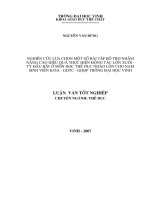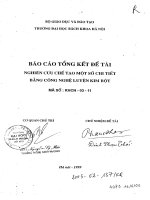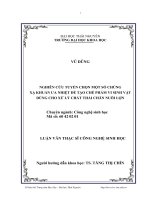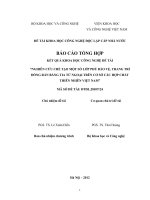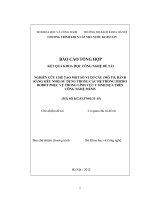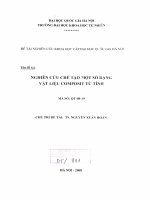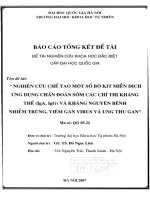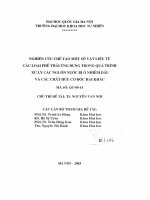Nghiên cứu chế tạo một số hệ nhũ tương sinh nhiệt để xử lý, ngăn ngừa lắng đọng parafin trong khai thác dầu thô ở Việt Nam
Bạn đang xem bản rút gọn của tài liệu. Xem và tải ngay bản đầy đủ của tài liệu tại đây (1.77 MB, 23 trang )
ĐẠI HỌC QUỐC GIA HÀ NỘI
TRƯỜNG ĐẠI HỌC KHOA HỌC TỰ NHIÊN
Nguyễn Thị Thu Hà
NGHIÊN CỨU CHẾ TẠO MỘT SỐ HỆ NHŨ TƯƠNG
SINH NHIỆT ĐỂ XỬ LÝ, NGĂN NGỪA LẮNG ĐỌNG PARAFIN
TRONG KHAI THÁC DẦU THÔ Ở VIỆT NAM
LUẬN ÁN TIẾN SĨ HÓA HỌC
Hà Nội - 2016
ĐẠI HỌC QUỐC GIA HÀ NỘI
TRƯỜNG ĐẠI HỌC KHOA HỌC TỰ NHIÊN
Nguyễn Thị Thu Hà
NGHIÊN CỨU CHẾ TẠO MỘT SỐ HỆ NHŨ TƯƠNG
SINH NHIỆT ĐỂ XỬ LÝ, NGĂN NGỪA LẮNG ĐỌNG PARAFIN
TRONG KHAI THÁC DẦU THÔ Ở VIỆT NAM
Chuyên ngành : Hóa dầu
Mã số
: 62440115
LUẬN ÁN TIẾN SĨ HÓA HỌC
Tập thể hướng dẫn khoa học :
1 - PGS.TS Hoa Hữu Thu
2 - TS Nguyễn Tấn Hoa
Hà Nội - 2016
LỜI CAM ĐOAN
Tôi xin cam đoan đây là công trình nghiên cứu của riêng rôi, các số liệu
và kết quả được đưa ra trong luận án này là trung thực, được các đồng tác giả
cho phép sử dụng và chưa từng được công bố trong bất kỳ công trình nào
khác.
Nghiên cứu sinh
Nguyễn Thị Thu Hà
LỜI CẢM ƠN
Với lòng biết ơn sâu sắc, em xin chân thành cảm ơn PGS.TS Hoa Hữu
Thu, TS Nguyễn Tấn Hoa đã định hướng đề tài và tận tình giúp đỡ, hướng
dẫn em trong suốt thời gian qua. Em cũng xin chân thành cảm ơn các thầy cô,
các anh chị, các bạn và các em trong Bộ môn Hóa học Dầu mỏ - Khoa Hóa
học – Trường Đại học Khoa học Tự nhiên – Đại học Quốc gia Hà Nội, đã tạo
điều kiện và giúp đỡ em hoàn thành luận án.
Em xin gửi lời cảm ơn chân thành đến các cán bộ, nhân viên của Trung
tâm Phân tích thí nghiệm – Viện Dầu khí Việt Nam và các cán bộ, nhân viên
trong Xí nghiệp Liên doanh Vietsovpetro đã tạo nhiều điều kiện để em thực
tập, nghiên cứu và ứng dụng thực tế các kết quả của luận án này.
Hà Nội, ngày 04 tháng 02 năm 2016
Nghiên cứu sinh
Nguyễn Thị Thu Hà
MỤC LỤC
MỞ ĐẦU ...................................................................................................................... 1
CHƯƠNG 1: TỔNG QUAN....................................................................................... 3
1.1. Các vấn đề liên quan đến hệ nhũ tương nước/dầu ........................................ 3
1.1.1. Khái niệm về nhũ tương ............................................................................. 3
1.1.2. Phân loại nhũ tương .................................................................................. 3
1.1.2.1. Phân loại dựa vào pha phân tán. .......................................................... 3
1.1.2.2. Phân loại theo nồng độ thể tích pha phân tán ...................................... 3
1.1.3. Phương pháp chế tạo nhũ tương ................................................................ 4
1.1.3.1. Nhũ hóa bằng phương pháp cơ học ...................................................... 4
1.1.3.2. Nhũ hóa bằng các chất hoạt động bề mặt (HĐBM) ............................. 6
1.1.4. Nhũ tương nước trong dầu và các yếu tố ảnh hưởng đến độ ổn định
của nhũ tương ....................................................................................................... 6
1.1.4.1. Sự hòa tan của các sản phẩm dầu trong nước ..................................... 6
1.1.4.2. Mô tả nhũ tương nước/dầu ................................................................... 6
1.1.5. Các yếu tố chính ảnh hưởng đến sự ổn định và phá vỡ của nhũ tương .. 8
1.1.5.1. Ổn định bằng lực đẩy tĩnh điện ............................................................ 8
1.1.5.2. Chất HĐBM tác động đến các yếu tố bề mặt của giọt nhũ tương ...... 10
1.1.6. Các tác nhân tạo nhũ và phân loại .......................................................... 14
1.1.6.1. Các tác nhân tạo nhũ .......................................................................... 15
1.4.6.2. Phân loại chất tạo nhũ theo tính chất của chất HĐBM ..................... 15
1.1.6.3. Hiện tượng tách nhũ – Độ bền nhũ..................................................... 18
1.2. Các vấn đề liên quan đến sự lắng đọng parafin ........................................... 20
1.2.1. Định nghĩa lắng đọng parafin .................................................................. 20
1.2.2. Tính chất của các LĐPA ........................................................................... 21
1.2.2.1. Độ cứng, độ rắn của các LĐPA .......................................................... 21
1.2.2.2. Nhiệt độ nóng chảy ............................................................................. 21
1.2.2.3. Tỷ trọng ............................................................................................... 21
1.2.2.4. Độ hòa tan .......................................................................................... 21
1.2.3. Các yếu tố ảnh hưởng đến LĐPA ............................................................ 22
1.2.3.1. Nhiệt độ ............................................................................................... 23
1.2.3.2. Thành phần của dầu thô ..................................................................... 23
1.2.3.3. Áp suất ................................................................................................ 24
1.2.3.4. Những yếu tố ảnh hưởng khác ............................................................ 24
1.2.4. Cơ chế LĐPA ............................................................................................. 25
1.2.4.1. Các cơ chế LĐPA .............................................................................. 25
1.2.4.2. Nghiên cứu cơ chế LĐPA trong công nghiệp dầu khí ....................... 27
1.3. LĐPA trong công nghiệp khai thác dầu khí ................................................ 29
1.3.1. LĐPA trong công nghiệp khai thác dầu thô ............................................ 29
1.3.2. LĐPA trong vận chuyển dầu thô .............................................................. 32
1.3.3. LĐPA trong tàng trữ, bảo quản dầu thô .................................................. 32
1.4. Các phương pháp xử lý LĐPA ...................................................................... 33
1.4.1. Phương pháp cơ học ................................................................................. 36
1.4.2. Phương pháp vật lý ................................................................................... 37
1.4.2.1. Kỹ thuật tiêm dầu nóng ....................................................................... 38
1.4.2.2. Đốt nóng đáy giếng ............................................................................. 38
1.4.2.3. Đốt nóng đường ống bằng kháng trở điện: ........................................ 38
1.4.3. Phương pháp hóa học ............................................................................... 39
1.4.4. Phương pháp hóa – lý ............................................................................... 39
1.5. Tình hình nghiên cứu, ứng dụng những công nghệ xử lý và ngăn ngừa
LĐPA trên thế giới và ở Việt Nam ....................................................................... 41
1.5.1. Tình hình nghiên cứu, ứng dụng những công nghệ xử lý và ngăn
ngừa LĐPA trên thế giới..................................................................................... 41
1.5.2. Các phương pháp xử lý, ngăn ngừa lắng đọng parafin tại Liên doanh
Việt – Nga “Vietsovpetro” ................................................................................... 43
CHƯƠNG 2: THỰC NGHIỆM VÀ CÁC PHƯƠNG PHÁP NGHIÊN CỨU..... 46
2.1. Các hóa chất sử dụng ..................................................................................... 46
2.1.1. Hóa chất..................................................................................................... 46
2.1.2. Các mẫu LĐPA.......................................................................................... 47
2.2. Các phương pháp nghiên cứu........................................................................ 47
2.2.1. Phương pháp xác định hiệu ứng nhiệt của phản ứng hóa học sinh
nhiệt trong các hệ vi nhũ .................................................................................... 47
2.2.2. Phương pháp xác định độ nhớt động học ................................................ 50
2.2.3. Phương pháp xác định nhiệt độ đông đặc của dầu thô theo tiêu chuẩn
ASTM D-97 .......................................................................................................... 50
2.2.4. Phương pháp xác định thành phần và phân bố parafin trong LĐPA
bằng sắc ký khí ở nhiệt độ cao ............................................................................ 51
2.2.5. Phương pháp xác định nhiệt độ nóng chảy của mẫu LĐPA .................. 51
2.2.6. Phương pháp xác định khả năng hòa tan LĐPA .................................... 52
2.2.7. Phương pháp thử nghiệm ngăn ngừa LĐPA. ......................................... 52
2.2.7.1. Lựa chọn loại PPD và dầu thô phù hợp ............................................. 54
2.2.7.2. Lựa chọn, xác định hàm lượng dung môi pha PPD .......................... 55
2.2.7.3. Chế tạo hệ hóa phẩm activator .......................................................... 55
2.2.8. Phương pháp đo độ bền nhũ hóa bằng ly tâm siêu tốc ........................... 56
2.2.9. Phương pháp xác định pH ........................................................................ 57
2.2.10. Phương pháp chụp ảnh hiển vi điện tử quét SEM ................................ 58
2.2.11. Thiết bị phòng thí nghiệm mô phỏng xử lý LĐPA trong ống khai
thác bằng các hệ vi nhũ tương sinh nhiệt .......................................................... 58
CHƯƠNG 3: KẾT QUẢ VÀ THẢO LUẬN ........................................................... 60
3.1. Kết quả xác định tính chất hóa lý của các mẫu LĐPA ở một số giếng
khai thác ở Việt Nam ............................................................................................. 60
3.1.1. Thành phần và nhiệt độ nóng chảy parafin ở mỏ dầu Bạch Hổ và
Rồng ..................................................................................................................... 60
3.1.2. Phân bố LĐPA dọc theo ống (cần) khai thác .......................................... 63
3.1.3. Phân tích hình thái LĐPA (ảnh SEM) .................................................... 65
3.2. Kết quả chế tạo các hệ nhũ tương hóa phẩm sinh nhiệt dựa trên phản
ứng oxi – hóa khử .................................................................................................. 66
3.2.1. Khả năng sinh nhiệt và động học của phản ứng giữa NH4Cl và
NaNO2 .................................................................................................................. 66
3.2.1.1. Ảnh hưởng của nồng độ xúc tác H+ .................................................... 66
3.2.1.2. Ảnh hưởng của nồng độ NH4Cl .......................................................... 68
3.2.2. Khả năng tạo nhũ của dung dịch các chất phản ứng NH4Cl và
NaNO2. ................................................................................................................. 69
3.2.2.1. Lựa chọn các chất HĐBM .................................................................. 69
3.2.2.2. Chuẩn bị các chất HĐBM ................................................................... 70
3.2.2.3. Các điều kiện chế tạo hệ nhũ .............................................................. 71
3.2.3. Lựa chọn pha dầu – dung môi.................................................................. 75
3.2.4. Các yếu tố ảnh hưởng đến khả năng sinh nhiệt và khả năng xử lý
LĐPA ................................................................................................................... 79
3.2.4.1. Ảnh hưởng của nồng độ chất HĐBM ................................................. 79
3.2.4.2. Ảnh hưởng của hàm lượng pha dầu ................................................... 81
3.2.4.3. Ảnh hưởng của tốc độ khuấy .............................................................. 84
3.2.5. Chế tạo hóa phẩm nhũ tương sinh nhiệt từ phản ứng oxi – hóa khử.... 87
3.2.5.1. Chuẩn bị các dung dịch muối ............................................................. 87
3.2.5.2. Tạo hệ nhũ tương ................................................................................ 87
3.3. Kết quả chế tạo các hệ nhũ tương sinh nhiệt từ phản ứng trung hòa ....... 89
3.3.1. Kết quả thử nghiệm khi sử dụng bazơ là etanolamin ............................. 90
3.3.2. Kết quả thử nghiệm khi sử dụng bazơ là etylen điamin .......................... 93
3.3.3. Kết quả thử nghiệm dùng bazơ là n-butylamin ....................................... 93
3.3.4. Kết quả thử nghiệm với bazơ là N,N-đibutylamin ................................... 95
3.3.5. Kết quả thử nghiệm khi sử dụng bazơ là hỗn hợp của hai amin
ethanolamin (EA) và ethylen điamin (EDA)...................................................... 96
Nhận xét: Khi sử dụng các amin hoặc hỗn hợp amin khác nhau, kết quả
thu được cho thấy đối với bazơ là n-butylamin thì nhiệt độ Tmax đạt được
cao nhất, độ pH =8,5 phù hợp cho môi trường làm việc và độ nhớt thấp. Vì
vậy đây là bazơ được lựa chọn cho các nghiên cứu tiếp theo. .......................... 97
3.3.6. Kết quả thử nghiệm với hàm lượng axit axetic khác nhau ..................... 97
3.37. Kết quả khảo sát ảnh hưởng của thành phần dung môi (kerosen +
xylen) đến nhiệt độ cao nhất Tmax của khối phản ứng và khả năng hòa tan
LĐPA ................................................................................................................... 98
3.3.8. Kết quả xác định độ nhớt của hỗn hợp sản phẩm sau phản ứng sinh
nhiệt khi thêm những lượng nước khác nhau ................................................ 100
3.4. Kết quả thử nghiệm ngăn ngừa lắng đọng parafin ................................... 103
3.4.1. Kết quả xác định nhiệt độ đông đặc mẫu dầu khi định lượng bằng
Basoflux PD 4119.............................................................................................. 103
3.4.2. Kết quả xác định nhiệt độ đông đặc mẫu dầu khi định lượng bằng
Sepaflux ES-3363 .............................................................................................. 104
3.4.3. Kết quả xác định nhiệt độ đông đặc mẫu dầu khi định lượng bằng VX
7484 .................................................................................................................... 104
3.4.4. Kết quả xác định nhiệt độ đông đặc mẫu dầu khi định lượng bằng
PAO 83363 ......................................................................................................... 105
3.4.5. Kết quả lựa chọn, xác định hàm lượng dung môi pha PPD ................. 106
3.4.6. Xác định tỷ lệ diezen/PPD phù hợp ........................................................ 107
3.4.7. Kết quả khảo sát khả năng tương tác của Sepaflux ES-3363 với
những alcohol riêng biệt ................................................................................... 108
3.4.8. Kết quả khảo sát tương tác của Sepaflux ES-3363 với những loại
activator chế tạo được ....................................................................................... 109
3.4.9. Đánh giá qua ly tâm siêu tốc sản phẩm tương tác giữa Sepaflux ES3363 với hoá phẩm activator chế tạo được ...................................................... 110
3.4.10. Kết quả đánh giá qua chỉ tiêu độ bền gel (gel strength) ...................... 111
3.4.11. Đánh giá qua thử nghiệm trên mô hình thiết bị phòng thí nghiệm .. 111
KẾT LUẬN .............................................................................................................. 115
DANH MỤC CÔNG TRÌNH KHOA HỌC CỦA TÁC GIẢ LIÊN QUAN ĐẾN
LUẬN ÁN ................................................................................................................. 117
TÀI LIỆU THAM KHẢO ...................................................................................... 118
DANH MỤC CÁC KÝ HIỆU VÀ CHỮ VIẾT TẮT
HĐBM : hoạt động bề mặt
LĐPA : lắng đọng parafin
DP
: deposit paraffin - lắng đọng parafin
FSO
: floating storage and offloading - kho nổi chứa và xuất dầu không có thiết
bị xử lý
PPD
: pour point depressant - chất làm giảm nhiệt độ đông đặc
WAT
: Wax Appearance Temperature - nhiệt độ xuất hiện sáp
TÀI LIỆU THAM KHẢO
TÀI LIỆU TIẾNG VIỆT
1. Đào Thị Hải Hà, Hoàng Linh, Lương Văn Tuyên (2013), “Tổng hợp phụ gia
giảm nhiệt độ đông đặc cho dầu thô nhiều parafin mỏ Bạch Hổ trong khai thác và
vận chuyển trên nền ester của poly-triethanolamine”, Tạp chí Dầu khí (5), tr. 26-35.
2. Từ Thành Nghĩa và các tác giả khác (2015), “Những khó khăn, thách thức của
Vietsovpetro trong vận chuyển dầu nhiều parafin bằng đường ống ngầm ngoài
khơi”, Tạp chí Thăm dò – Khai thác Dầu khí (5), tr. 18-23.
3. Nguyễn Hữu Niếu, Trần Vĩnh Diệu (2004), Hoá Lý Polyme, Nhà xuất bản Đại
Học Quốc Gia TP Hồ Chí Minh.
4. Nguyễn Phương Tùng, Nguyễn Thị Phương Phong, Bùi Quang Khánh Long, Vũ
Tam Huề (2002), “Một số chất hoạt động bề mặt ức chế lắng đọng, nâng cao khả
năng khai thác và vận chuyển dầu thô”, Tạp chí Dầu khí (2), tr. 41-45.
5. Trang web của Tập đoàn Dầu khí Việt Nam, www.pvn.vn
6. Trang web của Tập đoàn xăng dầu Việt Nam, www.petrolimex.com.vn
7. Viện Nghiên cứu Khoa học và Thiết kế Dầu khí biển (2011), Báo cáo đề tài
nghiên cứu khoa học NIPI-II.7.
8. Viện NCKH&TK LD Việt – Nga Vietsovpetro (2012), Tính lại trữ lượng dầu và
khí hoà tan mỏ Bạch Hổ đến thời điểm 01.07.2011.
TÀI LIỆU TIẾNG ANH
9. Aiyejina A., Chakrabarti D.P., Pilgrim A., Sastry M.K.S. (2011), “Wax
formation in oil pipelines: A critical review”, Int. J. Multiphase Flow 37, pp. 671694.
10. Alghanduri L.M., Elgarni L.M., Daridon J.L., Coutinho J.A.P. (2010),
“Characterization of Libyan Waxy crude oils”, Energy Fuels 24(5), pp. 3101-3107.
11. Bank R., Hoteit H., Firoozabadi A. (2007), “Matematical formulation and
numerical of wax deposition in pipelines from enthalpy-porosity approach and
irreversible thermodinaries”, Inter.Jour.of.Heat and Mass transfer
118
12. Barnea D. (1987), “A Unified Model for Predicting Flow Pattern Transitions
for the Whole Range Inclinations”, Int. J. Multiphase Flow 13, pp. 1-12.
13. Barnea D., Yacoub N. (1983), “Heat Transfer in Vertical Upwards gas-Liquid
Sluf Flow”, Intl. J. Heat Transfer 26(9), p. 1365.
14. Behbahani T.J., Beigi A.A.M., Taheri Z., Ghanbari B. (2015), “The effect of
amio [60] fullerene derivatives on pour and rheological properties of waxy crude
oil”, Journal of Molecular Liquids 211, pp. 308-314.
15. Bellos T.J. (1983), “Block polymers of alkanolamines”. US Patent No
4404362.
16. Bellos T.J., Lovett E.G. (1987), “Polyalkanolamines”. US Patent No 4840748.
17. Bendiksen K.H. & Espedal, M. (1992), "Onset of Slugging in Horizontal
Gas-Liquid Pipe Flow," Int. J. Multiphase Flow 18, pp. 237-247.
18. Bern P.A., Withers V.R., Cairns J.R. (1980), Wax deposition in crude oil
pipelines, Proc. Euro. Offshore petro. Conf. Exhib, London, England.
19. Beshagina E.V., Loskutova Y.V., Yudina N.V., Krutey A.A. (2014), “Paraffin
Blockage Specificsin Model Petroliferous Systems”, Procedia Chemistry 10, pp.
229-235.
20. Biao W. & Lijian D. (1995), Paraffin Characteristics of Paraffinic Crude Oils
in China and the Methods of Paraffin Removal and Inhibition, paper SPE 29954
presented at the 1995, Beijing.
21. Bilgesu H.I., Ameri S., Aminian K., Della-Guistina D.E. (1999), “A Study on
Paraffin Deposition and Removal Characteristics of Jacksonsburg-Stringtown Oil,
West Virginia”, Department of Petroleum & Natural Gas Engineering West
Virginia University Morgantown.
22. Bill J.P., Volk M. (1999), Proposal for Continued Study of Paraffin
Deposition in Multiphase Flowlines and Wellbores, University of Tulsa.
23. Bird R.B., Stewart W.E. (2002), Lightfoot, Transport Phenomena second.,
John Wiley.
119
24. Botero M.L., Mosbach S., Kraft M., Rodrigues E. (2014), “Sooting tendency
of paraffin components of diesel and gasoline in diffusion flames”, Fuel 126, pp. 815.
25. Brent A.D., Voller V.R., Reid K.J. (1988), “Enthalpy porosity technique for
modeling convection-diffusion phase-change: application to the melting of pure
metal”, Numer. Heat Mass Transfer 13(3), pp. 297-318.
26. Brill J.P. & Beggs H.D. (1998), Two-Phase Flow in Pipes, The University of
Tulsa, Tulsa, Oklahoma, 6thEd.
27. Brill J.P. & Mukerjee H. (1999), Multiphase Flow in Wells, SPE Monograph
17.
28. Brown T.S., Niesen V.G., Erickson D.D. (1995), “Measurement and
prediction of the kinetics of paraffin deposition”, J. Pet. Tech 47(4), pp. 328-329.
29. Burger E.D., Perkins T.K., Striegler J.H. (1981), “Studies of wax deposition in
the Trans-Alaska Pipeline”, J. Pet. Tech 33(6), pp. 1075-1086.
30. Carman P.C. (1937), “Fluid flow through granular beds”, Trans. Inst. Chem.
Eng 15a, pp. 150-166.
31. Carnahan N.F. (1985), Paraffin Deposition in Petroleum Production, SPE
19895, JPT.
32. Castro L.V., Vazquez F. (2008), “Copolymers as flow improvers for Mexican
crude oils”, Energy Fuels 22(6), pp. 4006 - 4011.
33. Cho S.Y. and Fogler H.S. (1998), “Efforts on solving the problem of paraffin
deposition. I: Using oil – Soluble inhibitors”.
34. Chung
T.H.
(1992),
Thermodynamic
Modeling
for
Organic
Solid
Precipitation, SPE 24851, 67th Annual Technical Conference and Exhibition –
Washington, DC.
35. Creek J.L., Matzain B., Apte M., Volk M., Delle Case E., Lund H. (1999),
Mechanisms for wax deposition, AIChE Spring National Meeting, Houston, TX.
36. Cussler E.L., Hughes S.E., Ward W.J. and Aris R. (1988) “Barrier
Membranes,” J. Memb. Sci. 38, p. 161.
120
37. Davis E.J., Hung S.C., and Arciero S. (1975), “An Analogy for Heat Transfer
with Wavy/Stratified Gas-Liquid Flow”, AIChE J. 21(5), pp. 872-878.
38. Davis E.J., Cheremisinoff N.P, and Sambasivan G. (1976), “Heat and
Momentum Transfer Analogies for Two-Phase Transfer Stratified and Annular
Flows”, Proceedings of Two-Phase Flow and Heat Transfer Symposium, Fort
Lauderdale, FL, pp. 577-608.
39. Dawson S. (1995), Simulation of Wax Deposition Case Study, paper
presented at 1995 IBC Advances in Multiphase Operation and Offshore
Conference, London, England.
40. Deen W.M. (1988), Analysis of Transport Phenomena, Oxford University
Press, New York.
41. Deshmukh S., Bharambe D.P. (2007), “Synthesis of polymeric pour point
depressants for Nada crude oil (Gujarat, India) and its impact on oil rheology”.
42. Dios A.L., Ali M.M.B., Platten J.K., Firoozabadi A. (2005), “Measurements of
molecular and thermal diffusion coefficient in ternary mixtures”, J. Chem. Phys
122(23), pp. 1-12.
43. Dobbs J.B. (1999), A Unique Method of Paraffin Control in Production
Operations, Society of Petroleum Engineers.
44. Dougherty R.L., Ghajar A.J., Kim D., Kim J. and Ryali V.K. (1997),
Multiphase Heat Transfer in Flowlines and Wellbores Final Report –Interim Phase,
The University of Tulsa Paraffin Deposition JIP.
45. Eastund B.J., Schmitt K.J., Meek D.L., Anderson D.C., Grisham G. (1989),
“New system stops paraffin buildrup”, Pet. Eng. Int 61(1), pp. 46-51.
46. Elphingston G.M., Greenhill K.L., Hsu J.J.C. (1999), “Modeling of multiphase wax deposition”, J. Energy Res. Tech 121(2), pp. 81-85.
47. Erickson D.D., Niesen V.G., and Brown T.S. (1993), Thermodynamic
Measurements and Prediction of Paraffin Precipitation in Crude oil, SPE 26604,
68th Annual Technical Conference and Exhibition – Houston, Texas.
121
48. Evdokimov I.N., Eliseev N.I., Aleksandr Losev P., and Novikov M.A. (2006),
Emerging petroleum – oriented nanotechnologies for reservoir engineering,
Gubkin Russian State University of Oil and Gas.
49. Firoozabadi A. (1999), Thermodynamics of Hydrocarbon Reservoirs,
McGraw-Hill, New York.
50. Forsdyke I. (1995), Internal Report: British Petroleum.
51. Fukui K., Meada K. (1998), “Numerical simulation of dynamic layer
solidification for a eutectic binary system”, J. Chem. Eng. Jpn 31(3), pp. 445-450.
52. Galeana C.L., Firoozabadi A., Prausnitz J.M. (1996), “Thermodynamics of
wax precipitation in petroleum mixtures”, AIChE J 42(1), pp. 239-248.
53. Gao C. (2003), Investigation of Long Term Paraffin Deposition Behavior for
South Pelto Oil, MS Thesis, TheUniversity of Tulsa, Tulsa, Oklahoma .
54. Ghajar A.J., Dougherty R.L., Kim D., Sofyan Y. and Ryali V.K. (1997),
Multiphase Heat Transfer in Flowlines and Wellbores Final Report –Phase I, The
University of Tulsa Paraffin Deposition JIP.
55. Ghajar A.J., Dougherty R.L., Kim D., Sofyan Y. and Ryali V.K. (1997),
Multiphase Heat Transfer in Flowlines and Wellbores Literature Survey –Part II,
The University of Tulsa Paraffin Deposition JIP.
56. Ghosh P., Das M. (2014), “Study of the influence of some polymeric additives
as viscosity in dex improvers and pour point depressants – Sythesis and
characterization”, Journal of Petroleum Science and Engineering 119, pp. 79-84.
57. Ghrayeb K., Firoozabadi A. (2000), “Molecular pressure and thermal diffusion
in nonideal multicomponent mixtures”, AIChE J 46(5), pp. 892-900.
58. Golczynski T.S. and Kempton E.C. (2006), “Understanding Wax Problems
Leads To Deepwater Flow Assurance Solutions”, Deepwater Technology Trends In
Offshore Oil And Gas Operations.
59. Hafiz A.A., Khidr T.T. (2007), “Hexa-triethanolamine oleat esters as pour
point depressant for waxy crude oils”, Journal of Petroleum Science and
Engineering 56, pp. 296-302.
122
60. Halse A.K., Schlabach M., Schuster J.K., Jones K.C., Steinnes E., Breivik K.
(2015), “Endosulfan, pentachlorobenzene and short-chain chlorinated paraffins in
background soils from Western Europe”, Environmental Pollution 196, pp. 21-28.
61. Hamouda A.A., Davidsen S. (1995), An approach for simulation of paraffinh
deposition in pipelines as a function of flow charateristics with reference to Tesside
oil pipeline, in: SPE 28966-MS, Proc. SPE Inr. Symp. On Olifield Chemistry, San
Antonio, TX.
62. Hamouda A.A., Ravnoy J.M. (1992), Prediction of wax deposition in pipelines
and field experience on the influence of wax on drag-reducer performance, in:
Offshore Tech. Conf., OTC 7060 24th Annual OTC in Houston, Texas.
63. Hamouda A.A. and Viken B.K. (1993), Wax Deposition Mechanism Under
High-Pressure and in Presence of Light Hydrocarbon, SPE 25189, International
Symposium on Oilfield Chemistry – New Orleans, Louisiana.
64. Heidemann R.A., Madsen J., Stenby E.H., Andersen S.I. (2005), “Wax
precipitation modeled with many mixed solid phases”, AIChE J 51(1), pp. 298-308.
65. Heinemann Z.E. (2005), “Fluid Flow In Porous”, Montanuniversitat Leoben
Petroleum Engineering Department.
66. Hernandez O. (2002), Investigation of Single-Phase Paraffin Deposition
Characteristics, MS Thesis, The University of Tulsa, Tulsa, Oklahoma.
67. Hetsroni G., Hu B.G., Yi J.H., Mosyak A., Yarin L.P., and Ziskin G. (1998),
“Heat Transfer in Intermittent Air-Water Flows - Part 2 - Upward Inclined Tube”,
Intl. J. Multiphase Flow 24(2), pp. 189-212.
68. Hsu J.J., Santamaria M.M., and Brubaker J.P. (1994), Wax Deposition of Waxy
Live Crudes under Turbulent Flow Conditions, SPE 28480 presented at SPE 69th
Annual Technical Conference and Exhibition, New Orleans, LA.
69. Hsu J.J.S. and Brubaker J.P. (1995), Wax Deposition Measurement and ScaleUp Modeling for Waxy Live Crudes under Turbulent Flow Conditions, SPE 29979,
International Meeting on Petroleum Engineering – Beijing.
123
70. Hsu J.J.C., Santamaria M.M., Brubaker J.P. (1994), Wax Deposition of Waxy
Live Crudes Under Turbulent Flow Conditions, SPE 28480, 69th Annual Technical
Conference and Exhibition – New Orleans, Louisiana.
71. Incropera F., DeWitt D. (1996), Fundamentals of Heat and Mass Transfer,
John Wiley and Sons.
72. Jaramillo E.R., Galeana C.L., Manero O. (2004), “Modeling wax deposition in
pipelines”, Petroleum Sci. Technol 27(7), pp.821-861.
73. Kakac S. and Yener Y. (1995), Convective Heat Transfer, 2nd Edition, CRC
Press.
74. Kaminsky R.D. (1999), Estimation of Two-Phase Flow Heat Transfer in
Pipes, paper presented at ASME ETCE, Houston, TX.
75. Keating J.F. (1994), Simulation of paraffin deposition and removal in
wellbores, Major Subiect: Petroleum Engineering.
76. Kelechukwu E.M., Hikmat S.S., Salim A., and Yassin A.A.M. (2010),
Influencing Factors Governing Paraffin Wax Deposition during Crude Production.
77. Kelechukwu E.M., Al Salim H.S., Saadi A. (2013), “Prediction of wax
deposition problems of hydrocarbon production system”, Journal of Petroleum
Science and Engineering 108, pp. 128-136.
78. Khidr T.T. (2007), “Synthesis and evaluation of copolymers as pour-point
depressants”. Petroleum Science and Technology 25(5), pp. 671-681.
79. Khidr T.T., Mohmoud S.A. (2007), “Dispersion of waxy gas oil by some
nonionic surfactant”, Journal of Dispersion, Science and Technology 28(8), pp.
1309 - 1315.
80. Khidr T.T., Azzam E.M.S., Mutaawa S.S., Oma A.M.A. (2007), Study of
some anionic surfactants as pour point depressants additives for a waxy gas oil,
Industrial Lubricantion and Tribology.
81. Kim D., Ghajar A.J., and Dougherty R.L. (1999), Development of Improved
Two-Phase Two-Component Pipe Flow Heat Transfer Correlations from Existing
124
Correlations and Published Data, presented at ASME/JSME Joint Thermal
Engineering Conference.
82.
Kudaibergenov S.E., Didukh A.G., Ibraeva Z.E., Bimendina L.E, Rullens F.,
Devillers M., Laschewsky A., Regular A. (2005), Hydrophobically Modified
Polyampholyte as Novel Pour Point Depressant, Wiley InterScience.
83. Lacroix M., Voller V.R. (1990), “Finite difference solution of solidification
phase change problem: transformed versus fixed grids”, Numer. Heat Mass
Transfer Part B Fundamentals 17(1), pp. 25-41.
84. Lira C.H.S. (2001), “Solidification in square section”, Theoria 10, pp. 47-56.
85. Lohrentz J., Bray B., Clark R. (1964), “Calculating viscosities of reservoir
fluids from their compositions”, J. Pet. Tech 16, pp. 1171-1176.
86.
Lund H. (1998), Investigation of Paraffin Deposition during Single-Phase
Flow, MS Thesis, The University of Tulsa, Tulsa, Oklahoma.
87. Luo X.J., Sun Y.X., Wu J.P., Chen S.J., Mai B.X. (2015), “Short-chain
chlorinated paraffins in terrestrial bird species inhabiting an e-waste recycling site
in South China”, Pollution 198, pp. 41-46.
88. Manabe R. (2000), A Comprehensive Mechanistic Heat Transfer Model for
Two-Phase Flow with High- Pressure Flow Pattern, Ph. D. Dissertation, The
University of Tulsa, Tulsa, Oklahoma.
89. Mansoori G.A. (2010), “Remediation of Asphaltene And Other Heavy Organic
Deposits In Oil Well And In Pipelines”, University of Illinois.
90. Marie E., Chevalier Y., Eydoux F., Germanaud L., Flores P. (2005), “Control
of n-alkanes crystallization by ethylene-vinyl acetate copolymers”, Journal of
Colloid and Interface Science 290, pp. 406-418.
91. Majeed A., Bringedal B., Overa S. (1990), “Model calculates wax deposition
for N. Sea oils”, Oil Gas J 88(25), pp. 63-69.
92. Majid S.A. (2013), “Determination of wax deposition and corrosion in
pipelines by neutron back diffusion collimation and neutron capture gamma rays”,
Applied Radiation and Isotopes 74, pp. 102-108.
125
93. Matzain A. (1996), Single-Phase Liquid Paraffin Deposition Modeling, MS
Thesis, The University of Tulsa, Tulsa, Oklahoma.
94. Matzain A. (1999), Multiphase Flow Paraffin Deposition Modeling, Ph.D.
Dissertation, The University of Tulsa, Tulsa, Oklahoma.
95. Mbaye M., Bilgen E. (2001), “Phase change process by natural convectondiffusion in rectangular enclosures”, Heat Mass Transfer 37(1), pp. 35-42.
96. McClafin G.G and Whitfill D.L. (1983), Control of Paraffin Deposition in
Production Operation,
SPE 12204, 58th Annual Technical Conference and
Exhibition – San Francisco, California.
97. Nalco Pacific PTE ltd (1998), “Nalco Squezze Treatment Slide”.
98. Nalco chemical company (1987), Method of utilizing paraffin inhibitors.
99. Narin G., Martins V.F.D., Campo.M, Ribeiro A.M., Ferreira A.,Santos J.C.,
Schumann K. (2014), “Light olefins/paraffins separation with 13X zeolite
binderless beads”, Separation and Purification Technology 133, pp. 452-475.
100. Narvaez C., Ferrer A.A., Corpoven S.A. (1991), Prevention of paraffin well
plugging by plunger-lift use, SPE 21640 presented at the SPE production operation
symposium, Oklahoma City, Oklahoma.
101. Nichita D., Goual L., Firoozabadi A. (2001), “Wax precipitation in gas
condensate systems”, SPE Prod. Facilit 16(4), pp. 250-259.
102. Noll L. (1992), Treating Paraffin Deposits In Producing Oil Wells, National
Institute for Petroleum And Energy Research Bartlesville, Oklahoma.
103. Palou R.M., Mosqueira M.L., Rendon B.Z., Marjuarez E., Huicochea C.B.,
Lopez J.C.C., Aburto J. (2011), “Transporttation of heavy and extra-heavy crude oil
by pipeline : A review”, Journal of Petroleum Science and Enginneering 75, pp.
274-282.
104. Pan H., Firrozabadi A. and Fotland P. (1997), “Preeure and Composition
Effect on Wax Precipitation: Experimental Data and Model Results”, SPE
Production & Facilities, pp. 250-258.
126
105. Pantankar S.V. (1980), Numerical Heat Transfer and Fluid Flow, Hemisphere
Publishing Corp., Washington.
106. Pedersen K.S., Skovborg P. and Ronningsen H.P. (1991), “Wax Precipitation
from North Sea Crude Oils-4: Thermodynamic Modeling”, Energy & Fuels 5(6),
pp. 924-931.
107. Pedersen K.S., Rønningsen H.P. (2003), “Influence of wax Inhibitors on wax
appearance temperature, pour point and viscosity of waxy crude oils”, Energy Fuels
17(2), pp. 321 - 328.
108. Rezkallah K.S. and Sims G.E. (1987), “An Examination of Correlations of
Mean Heat Transfer Coefficients in Two-Phase and Two-Component Flow in
Vertical Tubes,” AIChE Symp. Series 83, pp. 109-114.
109. Ribero F.S., Mends P.R.S., Braga S.L. (1997), “Onstruction of pipelines due
to paraffin deposition during the flow of the crude oil”, Int. J. Heat Mass Transfer
40(18), pp. 4319-4328.
110. Ring J.N. (1993), SPE, Chevron U.S.A. Inc., and R.A. Wattenbarger, SPE,
James F. Keating, and Sriram Peddibhotla, Simulation of paraffin deposition in
reservoirs, SPE, Texas A&M U.
111. Ring J.N., Wattenbarger R.A., James W. Keating, and Sriram Peddibhotla
(1994), Simulation of Paraffin Deposition in Reservoirs, SPE 24069, SPE Prouction
& Facilities.
112. Rygg O.B., Rydahl A.K. and Ronnigsen H.P. (1988), Wax Deposition in
Offshore Pipelines Systems, BHRG Multiophase Technology Conference, Banff,
Alberta, Canada.
113. Rosner D.E. (2000), Transpot Processes in Chemically Reacting Flow
Systems, Courier Dover Publications.
114. Sadeghazad A., Oskouei S.J.P. (2005), Experimental assessment of bacteria
ability to tackle the wax problem in the crude industry
115. Sarica C., Volk M. (2004), Tulsa University Paraffin Deposition Projects, The
University of Tulsa.
127
116. Shah M.M. (1981), “Generalized Prediction of Heat Transfer During TwoComponent Gas-Liquid Flow in Tubes and Other Channels”, AIChE Symp. Series
208, pp. 140-151.
117. Shafiei S.H., Serafini D., Mehrotra A.K. (2014), “A steady-state heat-transfer
model for solids deposition from waxy mixtures in a pipeline”, Fuel 137, pp. 346359.
118. Shahreyar N. (2000), “Review of faraffin control and removal in oil wells
using southwestern petroleum short course searchable database”, submitted to the
graduate faculty of Texas Tech University in partial fulfillment of the requirements
for the degree of master of science in petroleum engineering.
119. Shoham O., Dukler A.E., and Taitel Y. (1982), “Heat Transfer during
Intermittent/Slug Flow in Horizontal Tubes”, Ind. Eng. Chem. Fund. 21, pp. 312319.
120. Shroyer L.L, and Haynes J. (1992), Paraffin Control for oil well and transport
lines using linear kinetic cell technology, SWPSC, Lubbock, TX.
121. Singh P., Fogler H.S., Nagarajan N. (1999), “Predicyion of the wax content of
the incipient wax-oil in a flwloop: An application of the controlled-stress
rheometer”, J.Rheol 43(6), pp. 1437-1459.
122. Singh P., Fogler H.S., Venkatsean R., Nagarajan N. (2000), “Formation and
aging of incipient thin film wax-oil gels”, AIChEJ 46(5), pp. 1059-1074.
123. Singh P., Fogler H.S., Venkatesan R. (2001), “Morphological evolution of
thick wax deposits during aging”, AIChE J 47(1), pp. 6-18.
124. Sjoblom J., Aske N., Auflem I.H., Brandal O., Havre T.E., Saether O.,
Westvik A., Johnsen E.E. and Kallevik H. (2003), Our current undersanding of
water-in-crude oil emulsions. Recent characterisation techniques and high pressure
performance, Advances in colloid and interface sience.
125. Spratt T. (2003), Personal Communication – Nalco.
126. Svendsen J.A. (1993), “Mathematical modeling of wax deposition in oil
pipeline systems”, AIChE J 39(8), pp. 1377-1388.
128
127. Svetgoff J. (1984), “Paraffin problems can be resolved with chemicals”, Oil
and gas 82(9), pp. 79-82.
128. Vazquez D., and Mansoori G.A. (2000), Analysis of Heavy Organic Deposits,
Department of Chemical Engineering University of Illinois at Chicago.
129. Wang T., Yu J., Han S., Wang Y., Jiang G. (2015), “Levels of short chain
chlorinated paraffins in pine needles and bark and their vegetation-air partitioning in
urban areas”, Environmental Pollution 196, pp. 309-312.
130. Wang X.T., Wang X.K., Zhang Y., Chen L., Sun Y.F., Li M., Wu M.H.
(2014), “Short- and medium-chain chlorinated paraffin in urban soils of Shanghai:
Spatial distribution, homologue group patterns and ecological risk assessment”,
Science of The Total Environment 490, pp. 144-152.
131. Wang W., Huang Q. (2014), “Prediction for wax deposition in oil pipelines
validated by field pigging”, Journal of the Energy Institute 87(3), pp. 196-207.
132. Weingarten J.S. and Euchnerv J.A. (1986), Method for Predicting Wax
Precipitation and Deposition, SPE 15654, 61st Annual Technical Conference and
Exhibition – New Orleans, Louisiana.
133. Whiaker S. (1999), The Method of Volume Averaging, Kluwer Academic,
Springer, Boston.
134. Wilson J.J., Chee W., O’Grady C., and Bishop D.M (1993), “ A field stydy of
downhole microbial Paraffin control”, SWPSC, Lubbock, TX.
135. Won K.W. (1986), “Thermodynamics for Solid Solution-Liqid-Vapor
Equilibria: Wax Phase Formation from Heavy Hydrocarbon Mixtures”, Fluid Phase
Equilibria 30, pp. 265-279.
136. Xiao M., Li W.H, Lu M., Zhang Z.Z., Luo Y.J., Qiao W., Sun S.S., Zhong
W.Z., Zhang M. (2012), “Effect of microbial treatment on the prevention and
removal of paraffin deposits on stainless steel surfaces”, Bioresource Technology
124, pp. 227-232.
129
137. Xu J., Xing S., Qian H., Chen S., Wei X., Zhang R., Li L., Guo X. (2013),
“Effect of polar/nonpolar groups in comb-type copolymers on cold flowability and
paraffin crystallization of waxy oils”, Fuel 103, pp. 600-605.
138. Zhang H. (1999), Error Analysis of Wax Thickness Measurement.
139. Zhu T., Walker J.A., Liang J. (2008), “Evaluation of Wax Deposition and Its
Control During Production of Alaska North Slope Oils”, Petroleum Development
Laboratory Institute of Northern Engineering.
130
